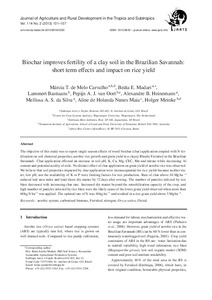Datum
2013Autor
Carvalho, Márcia T. de MeloMadari, Beáta E.Bastiaans, LammertOort, Pepijn A. J. vanHeinemann, Alexandre B.Silva, Mellissa A. S. daMaia, Aline de Holanda Nunes MaiaMeinke, HolgerSchlagwort
630 Landwirtschaft, VeterinärmedizinMetadata
Zur Langanzeige
Aufsatz

Biochar improves fertility of a clay soil in the Brazilian Savannah: short term effects and impact on rice yield
Zusammenfassung
The objective of this study was to report single season effects of wood biochar (char) application coupled with N fertilization on soil chemical properties, aerobic rice growth and grain yield in a clayey Rhodic Ferralsol in the Brazilian Savannah. Char application effected an increase in soil pH, K, Ca, Mg, CEC, Mn and nitrate while decreasing Al content and potential acidity of soils. No distinct effect of char application on grain yield of aerobic rice was observed. We believe that soil properties impacted by char application were inconsequential for rice yields because neither water, low pH, nor the availability of K or P were limiting factors for rice production. Rate of char above 16 Mg ha^(−1) reduced leaf area index and total shoot dry matter by 72 days after sowing. The number of panicles infected by rice blast decreased with increasing char rate. Increased dry matter beyond the remobilization capacity of the crop, and high number of panicles infected by rice blast were the likely cause of the lower grain yield observed when more than 60 kg N ha^(−1) was applied. The optimal rate of N was 46 kg ha^(−1) and resulted in a rice grain yield above 3 Mg ha^(−1).
Zitierform
In: Journal of Agriculture and Rural Development in the Tropics and Subtropics. Kassel : Kassel University Press. - Vol. 114, No. 2 (2013), S. 101-107Sammlung(en)
Vol 114, No 2 (2013) (Journal of Agriculture and Rural Development in the Tropics and Subtropics (JARTS))Zitieren
@article{urn:nbn:de:hebis:34-2013081343330,
author={Carvalho, Márcia T. de Melo and Madari, Beáta E. and Bastiaans, Lammert and Oort, Pepijn A. J. van and Heinemann, Alexandre B. and Silva, Mellissa A. S. da and Maia, Aline de Holanda Nunes Maia and Meinke, Holger},
title={Biochar improves fertility of a clay soil in the Brazilian Savannah: short term effects and impact on rice yield},
year={2013}
}
0500 Oax 0501 Text $btxt$2rdacontent 0502 Computermedien $bc$2rdacarrier 1100 2013$n2013 1500 1/eng 2050 ##0##urn:nbn:de:hebis:34-2013081343330 3000 Carvalho, Márcia T. de Melo 3010 Madari, Beáta E. 3010 Bastiaans, Lammert 3010 Oort, Pepijn A. J. van 3010 Heinemann, Alexandre B. 3010 Silva, Mellissa A. S. da 3010 Maia, Aline de Holanda Nunes Maia 3010 Meinke, Holger 4000 Biochar improves fertility of a clay soil in the Brazilian Savannah: short term effects and impact on rice yield / Carvalho, Márcia T. de Melo 4030 4060 Online-Ressource 4085 ##0##=u http://nbn-resolving.de/urn:nbn:de:hebis:34-2013081343330=x R 4204 \$dAufsatz 4170 7136 ##0##urn:nbn:de:hebis:34-2013081343330
<resource xsi:schemaLocation="http://datacite.org/schema/kernel-2.2 http://schema.datacite.org/meta/kernel-2.2/metadata.xsd"> 2014-02-03T12:14:55Z 2014-02-03T12:14:55Z 2013 1612-9830 urn:nbn:de:hebis:34-2013081343330 http://hdl.handle.net/123456789/2013081343330 eng Kassel University Press Urheberrechtlich geschützt https://rightsstatements.org/page/InC/1.0/ aerobic system carbonised biomass Ferralsol nitrogen Oryza sativa Oxisol 630 Biochar improves fertility of a clay soil in the Brazilian Savannah: short term effects and impact on rice yield Aufsatz The objective of this study was to report single season effects of wood biochar (char) application coupled with N fertilization on soil chemical properties, aerobic rice growth and grain yield in a clayey Rhodic Ferralsol in the Brazilian Savannah. Char application effected an increase in soil pH, K, Ca, Mg, CEC, Mn and nitrate while decreasing Al content and potential acidity of soils. No distinct effect of char application on grain yield of aerobic rice was observed. We believe that soil properties impacted by char application were inconsequential for rice yields because neither water, low pH, nor the availability of K or P were limiting factors for rice production. Rate of char above 16 Mg ha^(−1) reduced leaf area index and total shoot dry matter by 72 days after sowing. The number of panicles infected by rice blast decreased with increasing char rate. Increased dry matter beyond the remobilization capacity of the crop, and high number of panicles infected by rice blast were the likely cause of the lower grain yield observed when more than 60 kg N ha^(−1) was applied. The optimal rate of N was 46 kg ha^(−1) and resulted in a rice grain yield above 3 Mg ha^(−1). open access In: Journal of Agriculture and Rural Development in the Tropics and Subtropics. Kassel : Kassel University Press. - Vol. 114, No. 2 (2013), S. 101-107 Carvalho, Márcia T. de Melo Madari, Beáta E. Bastiaans, Lammert Oort, Pepijn A. J. van Heinemann, Alexandre B. Silva, Mellissa A. S. da Maia, Aline de Holanda Nunes Maia Meinke, Holger Gedruckte Ausg. im Verlag Kassel Univ. Press (www.upress.uni-kassel.de) erschienen. </resource>
Die folgenden Lizenzbestimmungen sind mit dieser Ressource verbunden:
Urheberrechtlich geschützt

